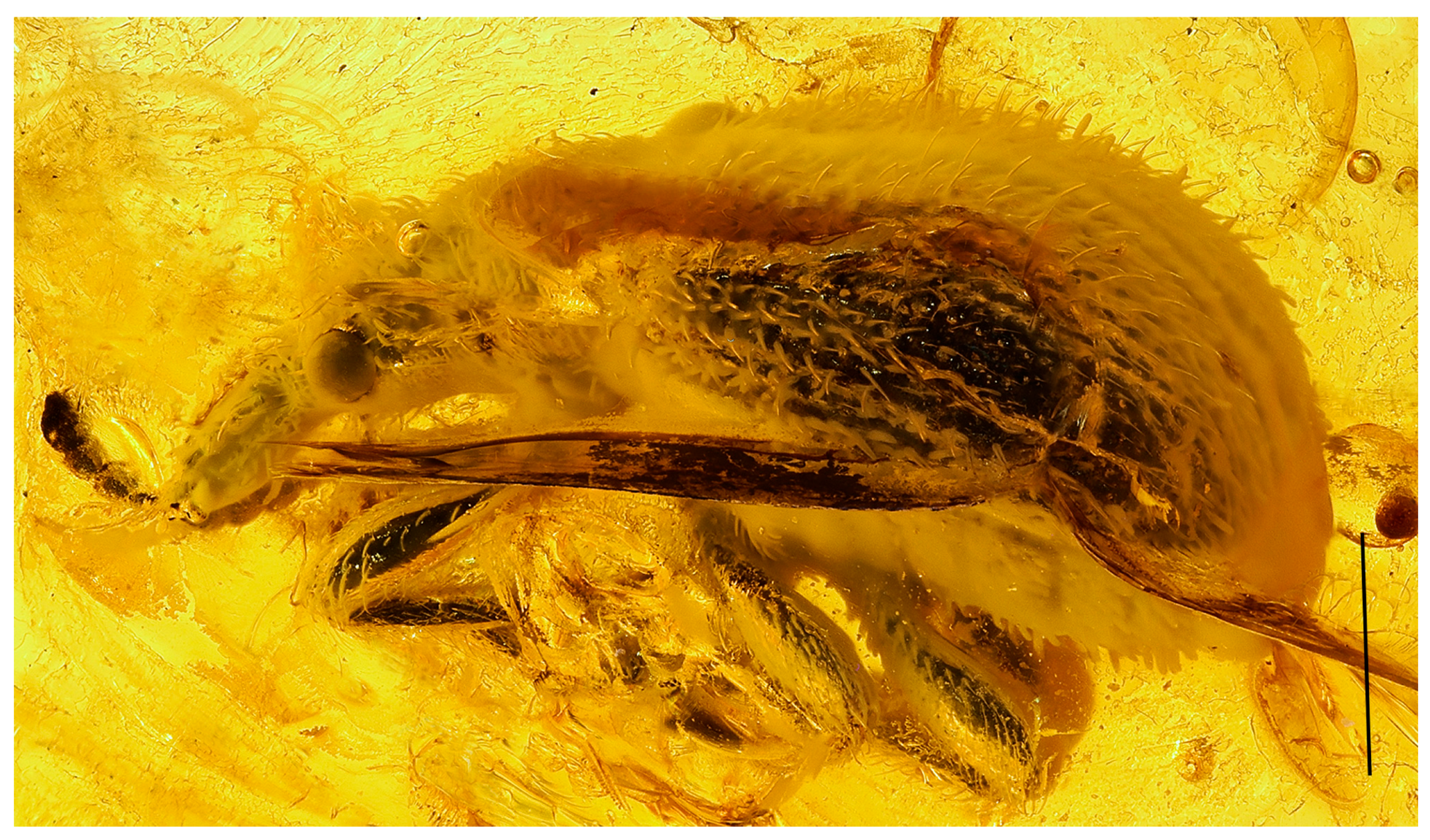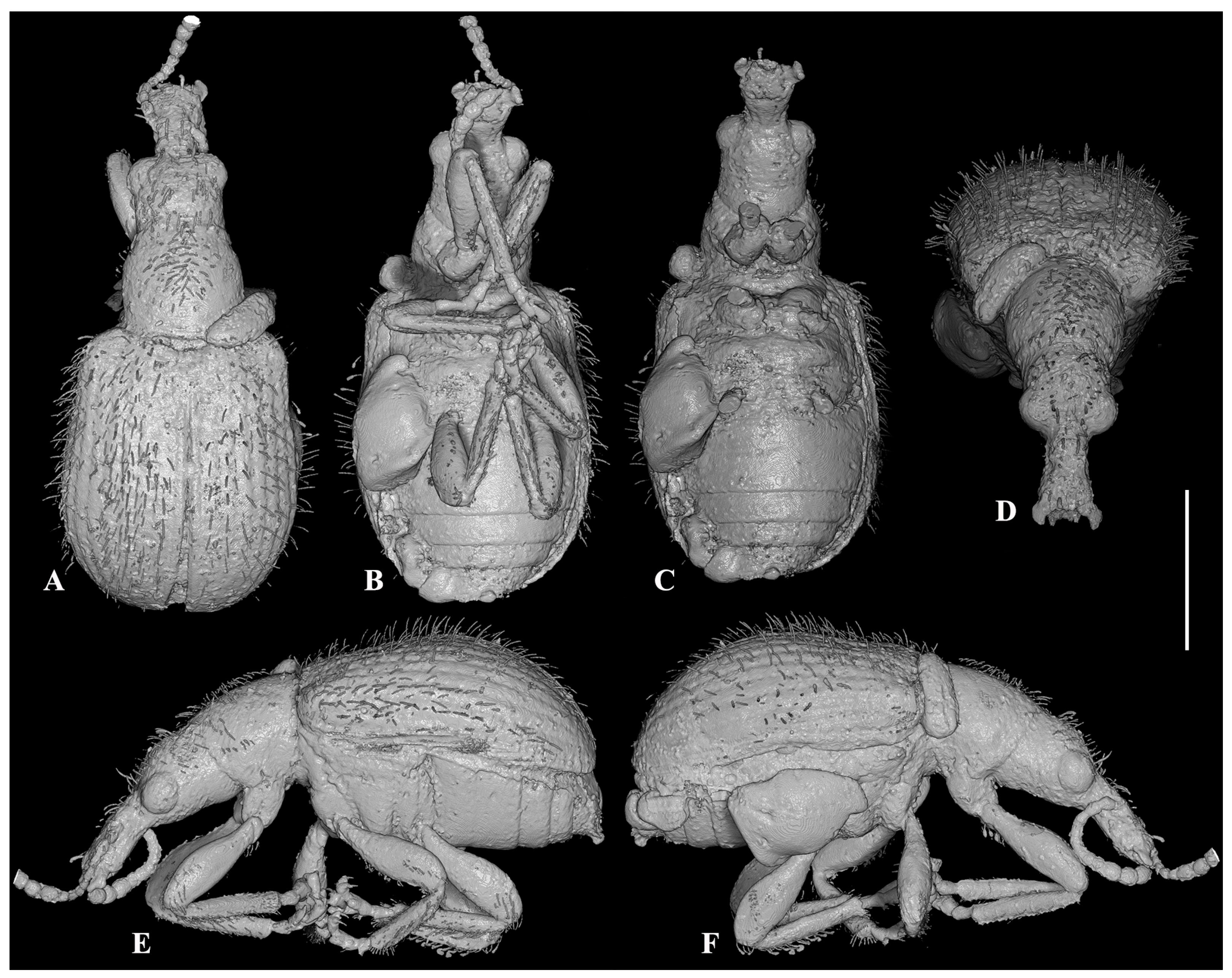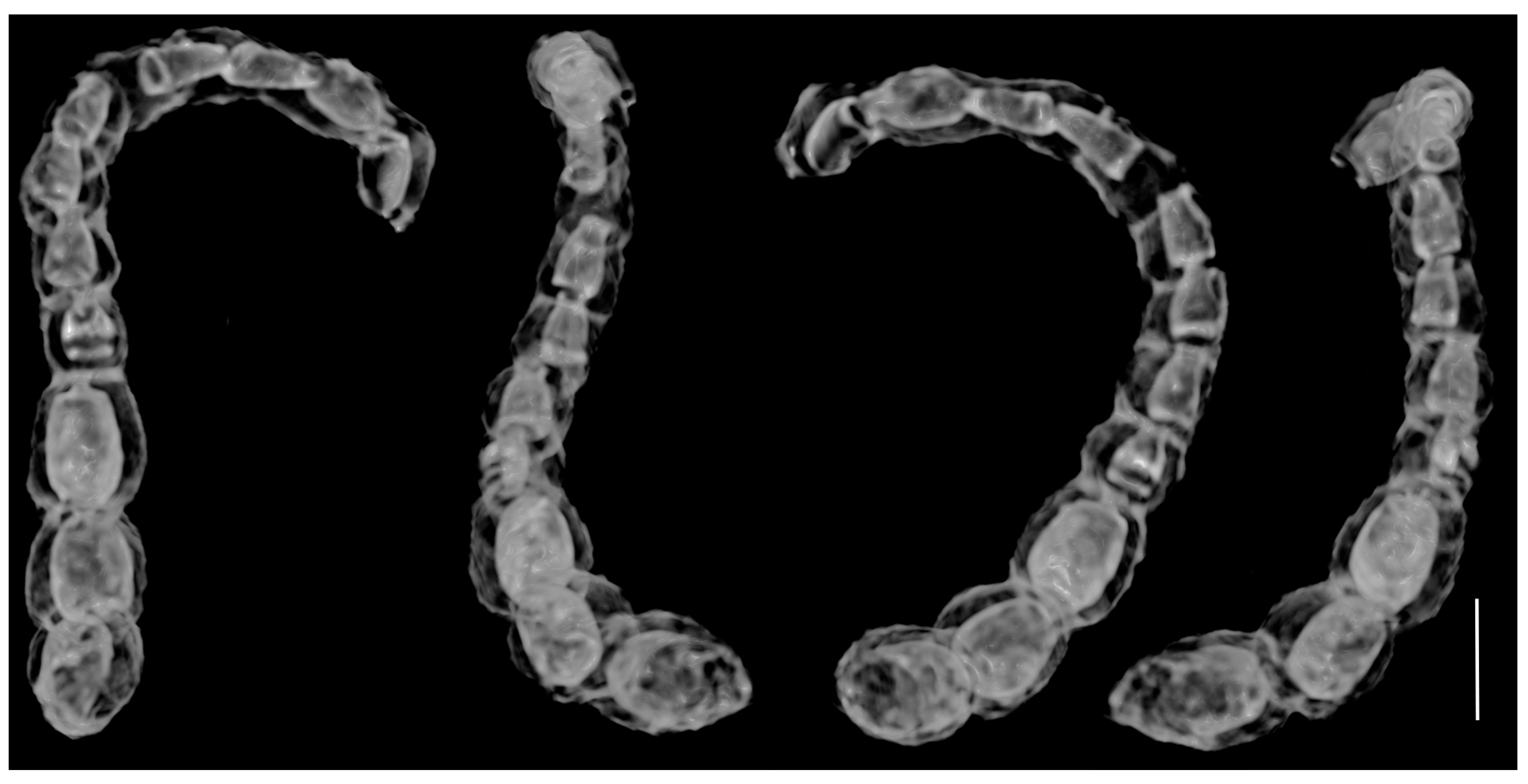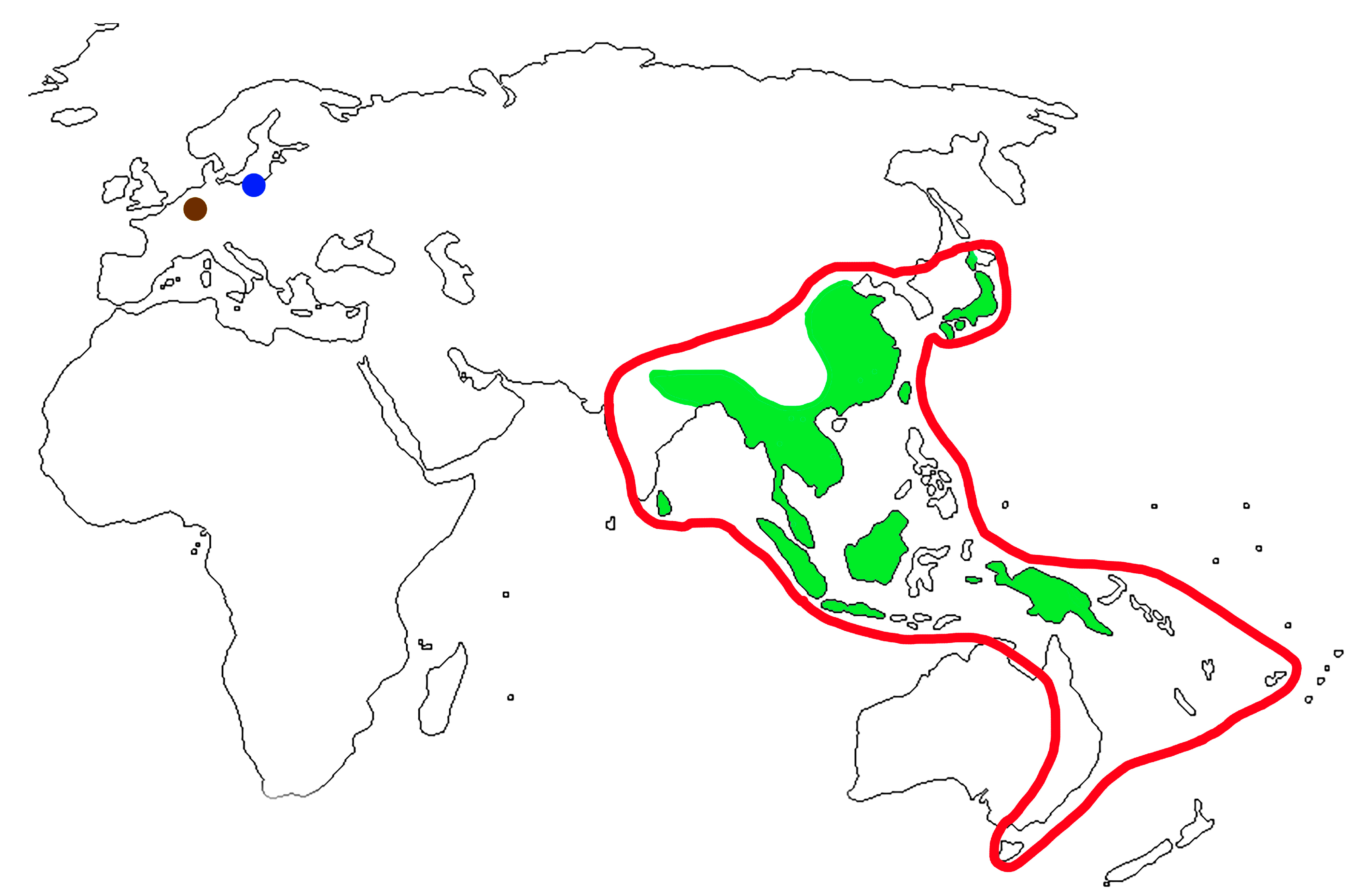First Record of the Genus Cartorhynchites Voss, 1958 (Coleoptera: Rhynchitidae) from Eocene Baltic Amber with a List of Fossil Tooth-Nosed Snout Weevils
Abstract
1. Introduction
2. Materials and Methods
3. Results
4. Discussion
5. Conclusions
Supplementary Materials
Author Contributions
Funding
Institutional Review Board Statement
Informed Consent Statement
Data Availability Statement
Acknowledgments
Conflicts of Interest
References
- Oberprieler, R.G.; Marvaldi, A.E.; Anderson, R.S. Weevils, weevils, weevils everywhere. Zootaxa 2007, 1668, 491–520. [Google Scholar] [CrossRef]
- Thompson, R.T. Observations on the morphology and classification of weevils (Coleoptera, Curculionoidea) with a key to major groups. J. Nat. Hist. 1992, 26, 835–891. [Google Scholar] [CrossRef]
- Kuschel, G. A phylogenetic classification of Curculionoidea to families and subfamilies. Mem. Entomol. Soc. Wash. 1995, 14, 5–33. [Google Scholar]
- Shin, A.; Clarke, D.J.; Lemmon, A.R.; Lemmon, E.M.; Aitken, A.L.; Haddad, S.; Farrell, B.D.; Marvaldi, A.E.; Oberprieler, R.G.; McKenna, D.D. Phylogenomic data yield new and robust insights into the phylogeny and evolution of weevils. Mol. Biol. Evol. 2017, 35, 823–836. [Google Scholar] [CrossRef] [PubMed]
- Cai, C.; Tihelka, E.; Giacomelli, M.; Lawrence, J.F.; Ślipiński, A.; Kundrata, R.; Yamamoto, S.; Thayer, M.K.; Newton, A.F.; Leschen, R.A.B.; et al. Integrated phylogenomics and fossil data illuminate the evolution of beetles. R. Soc. Open Sci. 2022, 9, 211771. [Google Scholar] [CrossRef] [PubMed]
- Zherikhin, V.V.; Egorov, A.B. Weevils (Coleoptera, Curculionidae) from Russian Far East; Institute Biology Soil Science: Vladivostok, Russia, 1991. [Google Scholar]
- Morimoto, K.; Kojima, H. Systematic position of the tribe Phylloplatypodini, with remarks on the definitions of the families Scolytidae, Platypodidae, Dryophthoridae and Curculionidae (Coleoptera: Curculionoidea). Esakia 2004, 44, 153–168. [Google Scholar] [CrossRef] [PubMed]
- Gratshev, V.G.; Legalov, A.A. The Mesozoic stage of evolution of the family Nemonychidae (Coleoptera, Curculionoidea). Paleontol. J. 2014, 48, 851–944. [Google Scholar] [CrossRef]
- Legalov, A.A. Fossil Mesozoic and Cenozoic weevils (Coleoptera, Obrienioidea, Curculionoidea). Paleontol. J. 2015, 49, 1442–1513. [Google Scholar] [CrossRef]
- Legalov, A.A. Annotated key to weevils of the world. Part 1. Families Nemonychidae, Anthribidae, Belidae, Ithyceridae, Rhynchitidae, Brachyceridae and Brentidae. Ukr. J. Ecol. 2018, 8, 780–831. [Google Scholar] [CrossRef]
- Motschulsky, V. Voyages. Lettres de M. de Motschulsky a M. Ménétriés, 4. Étud. Entomol. 1857, 5, 21–38. [Google Scholar]
- Wagner, H. Ein neues Apion aus dem baltischen Bernstein (Coleoptera, Curculionidae). Dtsch. Entomol. Z. 1924, 1924, 134–136. [Google Scholar]
- Hustache, A. Un curculionide de l’ambre de la Baltique. Bull. Mens. Soc. Lin. Lyon 1942, 11, 108–109. [Google Scholar] [CrossRef]
- Schedl, K. Die Borkenkäfer des baltischen Bernsteins. Zentralb. Ges. Entomol. 1947, 2, 12–45. [Google Scholar]
- Ulke, T. A new genus and species of Curculionidae (Coleoptera) in Baltic amber. Not. Nat. 1947, 19, 1–5. [Google Scholar]
- Voss, E. Einige Rhynchophoren der Bernsteinfauna (Col.). Mitt. Geol. Paläontol. Inst. Hambg. 1953, 22, 119–140. [Google Scholar]
- Zherikhin, V.V. On weevils (Insecta, Coleoptera) from the Baltic amber. Tr. Paleontol. Inst. Akad. Nauk SSSR 1971, 130, 197–209. [Google Scholar]
- Voss, E. Einige Rüsselkäfer der Tertiärzeit aus baltischen Bernstein (Coleoptera, Curculionidea). Steenstupia 1972, 2, 167–181. [Google Scholar]
- Wanat, M.; Borovec, L. New genus of weevil (Coleoptera, Curculionidae) from Baltic amber. Pol. Pismo Entomol. 1986, 56, 243–247. [Google Scholar]
- Kuska, A. Three new species of beetles (Coleoptera: Cantharidae, Anobiidae, Curculionidae) from the Baltic amber. Ann. Up. Sil. Mus. Bytom Entomol. 1992, 3, 107–113. [Google Scholar]
- Kuska, A. New beetle species (Coleoptera, Cantharidae, Curculionidae) from the Baltic amber. Prace Muz. Ziemi. 1996, 44, 13–23. [Google Scholar]
- Gratshev, V.G.; Zherikhin, V.V. A new anthribid genus from the Baltic amber (Insecta: Coleoptera: Anthribidae). Mitt. Geol. Paläontol. Inst. Hambg. 1995, 78, 149–157. [Google Scholar]
- Rheinheimer, J. Neue fossile Rüsselkäfer (Coleoptera: Curculionidae) aus dem Eozän des Baltischen Bernsteins und der Grube Messel bei Darmstadt. Staatl. Mus. Nat. 2007, 365, 1–24. [Google Scholar]
- Riedel, A. A new tribe, genus and species of Nemonychidae from Baltic amber (Coleoptera: Curculionoidea: Nemonychidae: Cimberidinae). Insect Syst. Evol. 2010, 41, 29–38. [Google Scholar] [CrossRef]
- Riedel, A.; dos Santos Rolo, T.; Cecilia, A.; van de Kamp, T. Sayrevilleinae Legalov, a newly recognised subfamily of fossil weevils (Coleoptera, Curculionoidea, Attelabidae) and the use of synchrotron microtomography to examine inclusions in amber. Zool. J. Linn. Soc. 2012, 165, 773–794. [Google Scholar] [CrossRef]
- Yunakov, N.N.; Kirejtshuk, A.G. New genus and species of broad-nosed weevils from Baltic amber and notes on fossils of the subfamily Entiminae (Coleoptera, Curculionidae). ZooKeys 2011, 160, 73–96. [Google Scholar] [CrossRef] [PubMed]
- Bukejs, A.; Legalov, A.A. Two new species of the family Rhynchitidae (Coleoptera: Curculionoidea) from Eocene Baltic amber, with key to species and assumed trophic relationships. Foss. Rec. 2021, 24, 117–127. [Google Scholar] [CrossRef]
- Kania, J.; Legalov, A.A. A new genus of tooth-nosed snout weevils (Coleoptera: Rhynchitidae) in Baltic amber. Paleontol. J. 2019, 53, 58–62. [Google Scholar] [CrossRef]
- Legalov, A.A. A new weevil genus of the tribe Metrioxenini (Coleoptera: Belidae) in Eocene Baltic amber. Hist. Biol. 2012, 24, 213–217. [Google Scholar] [CrossRef]
- Legalov, A.A. New Curculionoid beetles (Coleoptera: Curculionoidea) from the Baltic amber. Paleontol. J. 2012, 46, 262–272. [Google Scholar] [CrossRef]
- Legalov, A.A. New and little known weevils (Coleoptera: Curculionoidea) from the Paleogene and Neogene. Hist. Biol. 2013, 25, 59–80. [Google Scholar] [CrossRef]
- Legalov, A.A. A new species of the genus Pseudauletes Voss (Coleoptera: Rhynchitidae) from Baltic amber. Paleontol. J. 2022, 56, 559–563. [Google Scholar] [CrossRef]
- Legalov, A.A. A review of the Curculionoidea (Coleoptera) from European Eocene ambers. Geosciences 2020, 10, 16. [Google Scholar] [CrossRef]
- Legalov, A.A. Fossil history of Curculionoidea (Coleoptera) from the Paleogene. Geosciences 2020, 10, 358. [Google Scholar] [CrossRef]
- Sawada, Y. A systematic study of the family Rhynchitidae of Japan (Coleoptera, Curculionoidea). Hum. Nat. 1993, 2, 1–93. [Google Scholar]
- Zuppa, A.; Osella, G.; Biondi, S. Parental care in Attelabidae (Coleoptera, Curculionoidea). Ethol. Ecol. Evol. 1994, 3, 113–118. [Google Scholar] [CrossRef]
- Legalov, A.A. Leaf-Rolling Weevils (Coleoptera: Rhynchitidae, Attelabidae) of the World Fauna; Agro-Siberia: Novosibirsk, Russia, 2007. [Google Scholar]
- Pascoe, F.P. Descriptions of some new Asiatic species of Rhynchites. Ann. Mag. Nat. Hist. 1875, 16, 391–395. [Google Scholar] [CrossRef]
- Sharp, D. The rhynchophorous Coleoptera of Japan. Part I. Attelabidae and Rhynchitidae. Trans. Entomol. Soc. Lond. 1889, 1, 41–75. [Google Scholar]
- Voss, E. Entomologia Malayana Bakeri: Einige unbeschrebene Rhynchitinen (Coleoptera, Curculionidae) (25. Beitrag zur Kenntnis der Curculioniden). Philipp. J. Sci. 1932, 49, 555–563. [Google Scholar]
- Voss, E. Ein Beitrag zur Kenntnis der Attelabiden Javas (57. Beitrag zur Kenntnis der Curculioniden). Tijdschr. Voor Entomol. 1935, 78, 95–125. [Google Scholar]
- Voss, E. Monographie der Rhynchitinen Tribus Rhynchitini. V. 2. Teil der Monographie der Rhynchitinae-Pterocolinae. (45. Beitrag zur Kenntnis der Curculioniden). Koleopterol. Rundsch. 1938, 24, 129–171. [Google Scholar]
- Voss, E. Über Rüsselkäfer der indomalayischen Subregion, vorwiegend von Java (Col., Curc.) (82. Beitrag zur Kenntnis der Curculioniden). Tijdschr. Entomol. 1940, 83, 17–93. [Google Scholar]
- Voss, E. Ein Beitrag zur Kenntnis der Curculioniden im Grenzgebiet der orientalischen zur Paläarktischen Region (Coleoptera, Curculionidae). Die von J. Klapperich und Tschung Sen in der Provinz Fukien gesammelten Rüsselkäfer (132. Beitrag zur Kenntnis der Curculioniden). Decheniana 1958, 5, 1–139. [Google Scholar]
- Voss, E. Monographie der Rhynchitinen-Tribus Rhynchitini. 2. Gattungsgruppe: Rhynchitina (Coleoptera-Curculionidae). V.2. Teil der Monographie der Rhynchitinae-Pterocolinae). (195. Beitrag zur Kenntnis der Curculioniden). Entomol. Arb. Mus. Frey 1969, 20, 117–375. [Google Scholar]
- Voss, E. Coleoptera of the Loo-Choo Archipelago (III). 24. Families Attelabidae and Curculionidae. Uber Attelabiden und Curculioniden von den japanischen Inseln) (208. Beitrag zur Kenntnis der Curculioniden). Mem. Fac. Educ. Kagawa Univ. 1971, 2, 43–55. [Google Scholar]
- Egorov, A.B. Fam. Rhynchitidae–rinchitidy. In A Key to Insects of the Russian Far East; Ler, P.A., Ed.; Dal’nauka: Vladivostok, Russia, 1996; Volume 3, pp. 199–215. [Google Scholar]
- Zherichin, V.V. Tertiary weevils (Insecta, Coleoptera: Curculionoidea), identified from the collections of the Senckenberg Museum. Senckenberg. Lethaea 1992, 72, 169–178. [Google Scholar]
- Lawrence, J.F.; Beutel, R.G.; Leschen, R.A.B.; Slipinsky, S.A. Chapter 2. Glossary of morphological terms. In Handbook of Zoology. Arthropoda: Insecta. Coleoptera, Beetles. Volume 2: Morphology and Systematics (Elateroidea, Bostrichiformia, Cucujiformia Partim); Kristensen, N.P., Beutel, R.G., Eds.; Walter de Gruyter: Berlin, Germany; New York, NY, USA, 2010; pp. 9–20. [Google Scholar]
- Sadowski, E.-M.; Seyfullah, L.J.; Schmidt, A.R.; Kunzmann, L. Conifers of the ‘Baltic amber forest’ and their palaeoecological significance. Stapfia 2017, 106, 1–73. [Google Scholar]
- Sadowski, E.-M.; Schmidt, A.R.; Denk, T. Staminate inflorescences with in situ pollen from Eocene Baltic amber reveal high diversity in Fagaceae (oak family). Willdenowia 2020, 50, 405–517. [Google Scholar] [CrossRef]
- Seyfullah, L.J.; Beimforde, C.; Dal Corso, J.; Perrichot, V.; Rikkinen, J.; Schmidt, A.R. Production and preservation of resins-past and present. Biol. Rev. 2018, 93, 1684–1714. [Google Scholar] [CrossRef]
- Bukejs, A.; Alekseev, V.I.; Pollock, D.A. Waidelotinae, a new subfamily of Pyrochroidae (Coleoptera: Tenebrionoidea) from Baltic amber of the Sambian peninsula and the interpretation of Sambian amber stratigraphy, age and location. Zootaxa 2019, 4664, 261–273. [Google Scholar] [CrossRef]
- Kasiński, J.R.; Kramarska, R.; Słodkowska, B.; Sivkov, V.; Piwocki, M. Paleocene and Eocene deposits on the eastern margin of the Gulf of Gdańsk (Yantarny P-1 bore hole, Kaliningrad region, Russia). Geol. Q. 2020, 64, 29–53. [Google Scholar]
- Legalov, A.A. Contribution to the knowledge of the Mesozoic Curculionoidea (Coleoptera). Amur. Zool. Zh. 2009, 1, 283–295. [Google Scholar] [CrossRef]
- Gratshev, V.G.; Zherikhin, V.V. The weevils from the Late Cretaceous New Jersey amber (Coleoptera, Curculionoidea). In Studies on Fossils in Amber, with Particular Reference to the Cretaceous of New Jersey; Backhuys Publ.: Leiden, The Netherlands, 2000; pp. 241–254. [Google Scholar]
- Schlechtendal, D.H.R. Beiträge zur Kenntnis Fossiler Insekten aus dem Braunkohlengebirge von Rott am Siebengebirge. Abh. Naturforsch. Gesellsch. Halle 1894, 20. [Google Scholar]
- Scudder, S.H. Tertiary rhynchophorus Coleoptera of the United States. Monogr. US Geol. Surv. Tert. 1893, 21, 1–206. [Google Scholar]
- Wickham, H.F. A report on some recent of fossil Coleoptera from the Miocene Shales of Florissant. Bull. Lab. Nat. Hist. State Univ. Iowa 1912, 6, 3–38. [Google Scholar]
- Wickham, H.F. Fossil Coleoptera from the Wilson Ranch near Florissant, Colorado. Bull. Lab. Nat. Hist. State Univ. Iowa 1913, 6, 3–29. [Google Scholar]
- Wickham, H.F. Fossil Coleoptera from Florissant, with descriptions of several new species. Bull. Am. Mus. Nat. Hist. 1911, 30, 53–69. [Google Scholar]
- Poinar, G.; Legalov, A.A. Two new species of the genus Rhynchitobius Sharp, 1889 (Coleoptera: Rhynchitidae) in Dominican amber. Ann. Soc. Entomol. France (NS) 2015, 51, 70–77. [Google Scholar] [CrossRef]
- Heer, O. Die Insektenfauna der Tertiargebilde von Oeningen und von Radoboj in Croatien. Erste Theil. Käfer. Neue Denksch. Allgem. Schweizer. Gesellsch. Gesam. Naturwiss. Leipzig 1847, 8, 1–230. [Google Scholar]
- Ter-Minassian, M.E. New fossil species of the genus Rhynchites Schneid. (Coleoptera, Attelabidae) from the Binagady Beds. Dokl. Akad. Nauk Arm. SSR 1947, 7, 227–229. [Google Scholar]
- Wickham, H.F. New fossil Coleoptera from the Florissant beds. Bull. Lab. Nat. Hist. State Univ. Iowa 1916, 7, 3–20. [Google Scholar]
- Heyden, C.; Heyden, L. Käfer und Polypen aus der Braunkohle des Siebengebirges. Palaeontographica 1866, 15, 131–156. [Google Scholar]
- Piton, L. Paléontologie du Gisement Éocène de Menat (Puy-de-Dôme) (Flore et Faune); Imprim. Paul Vallier: Clermont-Ferrand, France, 1940. [Google Scholar]
- Wickham, H.F. On some fossil Rhynchophorus Coleoptera from Florissant Colorado. Bull. Am. Mus. Nat. Hist. 1912, 31, 41–55. [Google Scholar]
- Poinar, G.O.; Brown, A.E. Eugnamptus proterus sp. n. (Coleoptera: Curculionoidea: Rhynchitidae), a tooth nosed snout beetle in Mexican amber. Proc. Entomol. Soc. Wash. 2007, 109, 880–885. [Google Scholar]
- Penney, D.; Jepson, J.E. Fossil Insects: An Introduction to Palaeoentomology; Siri Scientific Press: Manchester, UK, 2014; pp. 1–223. [Google Scholar]
- Legalov, A.A. New species of the family Rhynchitidae (Coleoptera) from Asia and Africa. Stud. Rep. Distr. Mus. Prague-East. Taxonom. Ser. 2011, 7, 333–342. [Google Scholar]
- Heer, O. Die Urwelt der Schweiz; F. Schulthess Verlag: Zürich, Switzerland, 1865. [Google Scholar]
- Nazarov, V.I. New species of the entomofauna of the Mikulin Interglacial in Belarus. In Novyye i Maloizvestnyye Vidy Zhivotnykh i Rasteniy Belorussii; Nauka i Tekhnika: Minsk, Belarus, 1986; pp. 167–171. [Google Scholar]
- Sawada, Y. Oviposition behavior of two rhynchitid weevils (Coleoptera, Curculionoidea). Hum. Nat. 1994, 1, 57–61. [Google Scholar]
- Sadowski, E.M.; Hofmann, C.C. The largest amber-preserved flower revisited. Sci. Rep. 2023, 13, 17. [Google Scholar] [CrossRef]
- Weyland, H. Beiträge zur Kenntnis der Rheinischen Tertiärflora III. Palaeontographica 1938, 83, 123–171. [Google Scholar]
- Fanti, F. Malthodes michalskii: A new species of Cantharidae from Baltic amber (Coleoptera). G. It. Ent. 2017, 14, 685–690. [Google Scholar]
- Fanti, F. New fossil Cantharidae genus and species from Baltic amber (Insecta Coleoptera). G. It. Ent. 2017, 14, 709–714. [Google Scholar]
- Fanti, F. Malthodes meriae sp. nov.: A new fossil Malthodes Kiesenwetter, 1852 from the Eocene Baltic forests (Coleoptera: Cantharidae). Stud. Rep. Taxon. Ser. 2018, 14, 243–248. [Google Scholar]
- Fanti, F. New fossil Malthodes Kiesenwetter, 1852 of the subgenus Libertimalthodes Kupryjanowicz & Fanti, 2019 from Baltic amber (Coleoptera: Cantharidae). Palaeodiversity 2019, 12, 65–68. [Google Scholar]
- Fanti, F. Two new fossil soldier beetles from the Baltic amber (Coleoptera: Cantharidae). Stud. Rep. Taxon. Ser. 2020, 16, 13–19. [Google Scholar]
- Fanti, F. Two new Malthodes and a new Podistra from Eocene Baltic amber (Coleoptera, Cantharidae). Balt. J. Coleopterol. 2021, 21, 1–9. [Google Scholar]
- Fanti, F. A new genus of Cantharidae from Eocene Baltic amber found in Poland, with phoretic mites. Balt. J. Coleopterol. 2021, 21, 105–110. [Google Scholar]
- Fanti, F. Taxonomical notes on some fossil soldier beetles (Cantharidae). Balt. J. Coleopterol. 2022, 22, 319–325. [Google Scholar]
- Fanti, F. A new fossil of Mantimalthinus (Coleoptera: Cantharidae) sheds light on its tribal attribution. Stud. Rep. Taxon. Ser. 2022, 18, 281–286. [Google Scholar]
- Fanti, F.; Castiglione, E. Description of a new genus and species of Cantharidae from Eocene Baltic amber (Insecta, Coleoptera). Palaeodiversity 2017, 10, 123–127. [Google Scholar] [CrossRef][Green Version]
- Fanti, F.; Damgaard, A.L. Fossil soldier beetles from Baltic amber of the Anders Damgaard amber collection (Coleoptera Cantharidae). Balt. J. Coleopterol. 2018, 18, 1–32. [Google Scholar]
- Fanti, F.; Damgaard, A.L. New soldier beetles (Cantharidae) from Baltic, Burmese and Dominican ambers of the Anders Damgaard amber collection. Balt. J. Coleopterol. 2019, 19, 101–125. [Google Scholar]
- Fanti, F.; Damgaard, A.L. Fossil soldier beetles of the Anders Damgaard amber collection. Fourth update. Balt. J. Coleopterol. 2020, 20, 125–139. [Google Scholar]
- Fanti, F.; Kupryjanowicz, J. A new soldier beetle from Eocene Baltic amber. Acta Palaeontol. Pol. 2017, 62, 785–788. [Google Scholar] [CrossRef][Green Version]
- Fanti, F.; Kupryjanowicz, J. Discovery of a new fossil soldier beetle in Eocene Baltic amber, with the establishment of the new tribe Cacomorphocerini. Ann. Paléontol. 2018, 104, 149–153. [Google Scholar] [CrossRef]
- Fanti, F.; Michalski, A.R. An unusual fossil Malthodes with long elytra (Insecta Coleoptera Cantharidae). G. It. Ent. 2018, 15, 127–132. [Google Scholar]
- Fanti, F.; Pankowski, M.J. A new fossil soldier beetle (Coleoptera, Cantharidae, Silinae) from Eocene Baltic amber. Zootaxa 2018, 4370, 189–193. [Google Scholar] [CrossRef] [PubMed]
- Fanti, F.; Pankowski, M.K. Three new species of soldier beetles from Baltic amber (Coleoptera, Cantharidae). Zootaxa 2018, 4455, 513–524. [Google Scholar] [CrossRef] [PubMed]
- Fanti, F.; Pankowski, M.K. A new soldier beetle of the extinct tribe Cacomorphocerini Fanti & Kupryjanowicz, 2018. Zootaxa 2019, 4651, 589–595. [Google Scholar]
- Fanti, F.; Pankowski, M.G. A new Eocene soldier beetle (Cantharidae) of the genus †Cacomorphocerus Schaufuss, 1892 from Baltic amber. Zootaxa 2020, 4869, 437–443. [Google Scholar] [CrossRef]
- Fanti, F.; Pankowski, M.G. Two new species of Cantharis Linnaeus, 1758 from Baltic amber. Zootaxa 2020, 4878, 401–411. [Google Scholar] [CrossRef]
- Fanti, F.; Pankowski, M.G. A new fossil Silis Charpentier, 1825 from Baltic amber (Cantharidae, Silinae, Silini). Zootaxa 2022, 5195, 087–091. [Google Scholar] [CrossRef]
- Fanti, F.; Sontag, E. A new fossil soldier beetle (Coleoptera: Cantharidae: Malthininae) from Baltic amber. Zootaxa 2019, 4629, 583–588. [Google Scholar] [CrossRef]
- Fanti, F.; Vitali, F. Key to fossil Malthininae, with description of two new species in Baltic amber (Coleoptera Cantharidae). Balt. J. Coleopterol. 2017, 17, 19–27. [Google Scholar]
- Fanti, F.; Vitali, F. A new species of the enigmatic genus Kuskaella Fanti & Kupryjanowicz, 2017 (Coleoptera, Cantharidae) from Baltic amber. Balt. J. Coleopterol. 2020, 20, 1–6. [Google Scholar]
- Kazantsev, S.V. New taxa of Baltic amber soldier beetles (Insecta: Coleoptera: Cantharidae) with synonymic and taxonomic notes. Russ. Entomol. J. 2013, 22, 283–293. [Google Scholar]
- Kazantsev, S.V. New Baltic amber soldier beetles (Coleoptera, Cantharidae, Cantharinae). Euroasian Entomol. J. 2018, 17, 146–152. [Google Scholar] [CrossRef]
- Kazantsev, S.V. New Baltic amber soldier beetles (Insecta: Coleoptera: Cantharidae) with some taxonomic notes. Palaeoentomology 2020, 3, 260–268. [Google Scholar] [CrossRef]
- Kazantsev, S.V. New species of Baltic amber soldier beetles (Insecta: Coleoptera: Cantharidae). Russ. Entomol. J. 2021, 30, 153–158. [Google Scholar] [CrossRef]
- Kupryjanowicz, J.; Fanti, F. New subgenus and three new species of soldier beetles from the Eocene of Baltic amber. Palaeontol. Electron. 2019, 22, 1–14. [Google Scholar] [CrossRef] [PubMed]
- Pankowski, M.G.; Fanti, F. Two new fossil species of soldier beetles (Coleoptera, Cantharidae, Malthininae) from Baltic amber. Zootaxa 2022, 5165, 548–556. [Google Scholar] [CrossRef]
- Pankowski, M.G.; Fanti, F. Six new species of fossil soldier beetles (Coleoptera: Cantharidae) from Eocene Baltic amber. Palaeoentomology 2023, 6, 300–312. [Google Scholar] [CrossRef]
- Parisi, F.; Fanti, F. A new fossil Malthodes Kiesenwetter, 1852 from the Eocene Baltic amber (Coleoptera Cantharidae). Zootaxa 2019, 4652, 189–195. [Google Scholar] [CrossRef]
- Parisi, F.; Fanti, F. A new fossil species of the extinct tribe Mimoplatycini Kazantsev, 2013 (Coleoptera Cantharidae). Ann. Paléontol. 2019, 105, 119–122. [Google Scholar] [CrossRef]
- Parisi, F.; Fanti, F. On the first Silis Charpentier, 1825 from Baltic amber (Coleoptera, Cantharidae). Foss. Rec. 2019, 22, 119–123. [Google Scholar] [CrossRef]
- Parisi, F.; Fanti, F. Baltic amber: A new Cacomorphocerus Schaufuss, 1892 with two specimens preserved in a single piece, and four new Malthodes Kiesenwetter, 1852. Zootaxa 2020, 4778, 546–560. [Google Scholar] [CrossRef] [PubMed]
- Wentzel, D.; Bonino, E.; Fanti, F. A new Cacomorphocerus Schaufuss, 1892 (Cantharidae) from Baltic amber. Balt. J. Coleopterol. 2022, 22, 313–318. [Google Scholar]
- Szawaryn, K.; Szwedo, J. Have ladybird beetles and whiteflies coexisted for at least 40 Mya? PalZ 2018, 92, 593–603. [Google Scholar] [CrossRef]
- Szawaryn, K. Unexpected diversity of whitefly predators in Eocene Baltic amber-new fossil Serangium species (Coleoptera: Coccinellidae). Zootaxa 2019, 4571, 270–276. [Google Scholar] [CrossRef]
- Szawaryn, K. The first fossil Microweiseini (Coleoptera: Coccinellidae) from the Eocene of Europe and its significance for the reconstruction of the evolution of ladybird beetles. Zool. J. Linn. Soc. 2021, 193, 1294–1309. [Google Scholar] [CrossRef]
- Szawaryn, K.; Tomaszewska, W. New and known extinct species of Rhyzobius Stephens, 1829 shed light on the phylogeny and biogeography of the genus and the tribe Coccidulini (Coleoptera: Coccinellidae). J. Syst. Palaeontol. 2020, 18, 1445–1461. [Google Scholar] [CrossRef]
- Szawaryn, K.; Tomaszewska, W. The first fossil sticholotidini ladybird beetle (Coleoptera, Coccinellidae) reveals a transition zone through northern Europe during the Eocene. Pap. Palaeontol. 2020, 6, 651–659. [Google Scholar] [CrossRef]
- Vitali, F. Six new fossil cerambycids included in Baltic and Saxon amber (Coleoptera Cerambycidae). Entomapeiron (PS) 2011, 4, 1–34. [Google Scholar]
- Vitali, F. New fossil cerambycids (Coleoptera: Cerambycidae) from Baltic amber belonging to the collection Hoffeins. Balt. J. Coleopterol. 2014, 14, 103–112. [Google Scholar]
- Vitali, F. Mesalocerus tetropoides n. gen., n. sp. from Baltic amber: The first fossil member of the tribe Anisarthrini Mamaev & Danilevsky, 1973 (Coleoptera, Cerambycidae). Cah. Mage. NS 2015, 18, 69–73. [Google Scholar]
- Vitali, F. Obrium damgaardi sp. n. (Coleoptera: Cerambycidae), the first fossil species of the genus Obrium Dejean from the Baltic amber. Balt. J. Coleopterol. 2015, 15, 165–170. [Google Scholar]
- Vitali, F. Eurapatophysis groehni n. gen. and n. sp. (Coleoptera: Cerambycidae) from Baltic amber: The first fossil member of the tribe Apatophyseini Lacordaire, 1869. Balt. J. Coleopterol. 2016, 16, 117–122. [Google Scholar]
- Vitali, F. Two new fossil species of Tillomorphites Vitali (Coleoptera: Cerambycidae) and remarks on the morphological evolution, mimicry, biogeography and phylogeny of the tribe Tillomorphini. Balt. J. Coleopterol. 2017, 17, 147–160. [Google Scholar]
- Vitali, F. Procleomenes gouverneuri sp. n. (Coleoptera: Cerambycidae) from Baltic amber: The first fossil member of the tribe Sestyrini Lacordaire, 1869. Balt. J. Coleopterol. 2018, 18, 33–38. [Google Scholar]
- Vitali, F. Paratimia succinicola sp. n. (Coleoptera: Cerambycidae) from Baltic amber, with palaeogeographical remarks on the tribe Atimiini LaConte, 1873. Balt. J. Coleopterol. 2020, 20, 53–60. [Google Scholar]
- Vitali, F. Eurocrossotus alekseevi gen. n., sp. n. (Coleoptera: Cerambycidae) from Baltic amber, the first fossil member of the tribe Crossotini Thomson, 1864. Balt. J. Coleopterol. 2021, 21, 221–228. [Google Scholar]
- Vitali, F. Two new Pogonocherus species (Coleoptera: Cerambycidae) from Baltic amber. Balt. J. Coleopterol. 2022, 22, 103–110. [Google Scholar]
- Vitali, F.; Daamgard, A.L. Dicentrus mehli sp. n. (Coleoptera: Cerambycidae) implies close trophic association between Opsimini and Calocedrus, dating back the Baltic amber to the Early Oligocene. Balt. J. Coleopterol. 2016, 16, 37–43. [Google Scholar]
- Alekseev, P.I. The revision of gymnosperm species from Eocene Baltic amber. Bot. Zh. 2018, 103, 229–245. [Google Scholar]
- Alekseev, P.I.; Gnilovskaja, A.A. The diversity of Pinaceae pollen cones from Baltic amber (Late Eocene). Palaeobotany 2016, 7, 47–55. [Google Scholar] [CrossRef]
- Ignatov, M.S.; Abakarova, A.S.; Alekseev, P.I.; Kučera, J. Cynodontium eocenicum, a new moss from the Baltic amber. Arctoa 2016, 25, 236–240. [Google Scholar]
- Tarasevich, V.F.; Alekseev, P.I. Inclusions of angiosperm pollen in the Baltic amber (Late Eocene). Bot. Zh. 2017, 102, 206–213. [Google Scholar]
- Sadowski, E.-M.; Seyfullah, L.J.; Regalado, L.; Skadell, L.E.; Gehler, A.; Gröhn, C.; Hoffeins, C.; Hoffeins, H.W.; Neumann, C.; Schneider, H.; et al. How diverse were ferns in the Baltic amber forest? J. Syst. Evol. 2019, 4, 305–328. [Google Scholar] [CrossRef]
- Sadowski, E.-M.; Schmidt, A.R.; Kuzmann, L. The hyperdiverse conifer flora of the Baltic amber forest. Palaeontogr. Abt. B Palaeophytologie 2022, 304, 1–148. [Google Scholar] [CrossRef]




Disclaimer/Publisher’s Note: The statements, opinions and data contained in all publications are solely those of the individual author(s) and contributor(s) and not of MDPI and/or the editor(s). MDPI and/or the editor(s) disclaim responsibility for any injury to people or property resulting from any ideas, methods, instructions or products referred to in the content. |
© 2023 by the authors. Licensee MDPI, Basel, Switzerland. This article is an open access article distributed under the terms and conditions of the Creative Commons Attribution (CC BY) license (https://creativecommons.org/licenses/by/4.0/).
Share and Cite
Legalov, A.A.; Bukejs, A.; Vanaga, A.; Alekseev, V.I. First Record of the Genus Cartorhynchites Voss, 1958 (Coleoptera: Rhynchitidae) from Eocene Baltic Amber with a List of Fossil Tooth-Nosed Snout Weevils. Life 2023, 13, 1920. https://doi.org/10.3390/life13091920
Legalov AA, Bukejs A, Vanaga A, Alekseev VI. First Record of the Genus Cartorhynchites Voss, 1958 (Coleoptera: Rhynchitidae) from Eocene Baltic Amber with a List of Fossil Tooth-Nosed Snout Weevils. Life. 2023; 13(9):1920. https://doi.org/10.3390/life13091920
Chicago/Turabian StyleLegalov, Andrei A., Andris Bukejs, Anarina Vanaga, and Vitalii I. Alekseev. 2023. "First Record of the Genus Cartorhynchites Voss, 1958 (Coleoptera: Rhynchitidae) from Eocene Baltic Amber with a List of Fossil Tooth-Nosed Snout Weevils" Life 13, no. 9: 1920. https://doi.org/10.3390/life13091920
APA StyleLegalov, A. A., Bukejs, A., Vanaga, A., & Alekseev, V. I. (2023). First Record of the Genus Cartorhynchites Voss, 1958 (Coleoptera: Rhynchitidae) from Eocene Baltic Amber with a List of Fossil Tooth-Nosed Snout Weevils. Life, 13(9), 1920. https://doi.org/10.3390/life13091920






